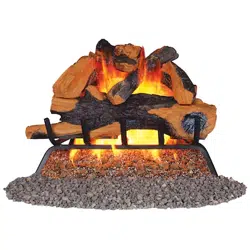Loading ...
Loading ...
Loading ...

©2017 Pinnacle Climate Technologies 17 Vented Gas Log Appliance User’s Manual
Troubleshooting Guide
Turn o and let the appliance cool before servicing. Only a qualied service person
should service and repair the appliance.
WARNING
Problem Possible Cause Solution
Appliance is smoking/
sooting excessively
Note: It is natural
and unavoidable
for vented gas log
sets to create some
level of soot where
ames contact the
logs.
1. Poor fuel quality
2. Fireplace venting system not
drafting properly
3. Excessive ame impingement
or blockage
4. Improper fuel/air mixture
5. Excessive gas supply/pressure
6. Damper closed or not open
suciently
1. Contact local natural gas company.
2. Adjust damper wide open and/or have replace
and venting professional cleaned and checked.
3. Separate the logs to allow more ame passage.
4. Remove any foreign items from the ame pattern.
5. Preheat ue in very cold weather.
6. Open the damper fully when operating the
gas log set.
Burner is overly
noisy.
Note: The
combustion of
gas creates a low
level of noise that
cannot be avoided.
1. Passage of air/gas across
irregular surfaces
1. Fix any tight bends or kinks in gas supply line.
Burner ame is too
high or too low.
1. Incorrect gas supply or pressure
2. Blocked burner orice or burner
manifold ports
3. Wrong burner orice size
4. Valve not operating properly
5. High altitude
1. Check for proper gas supply pressure.
2. Free burner orice and manifold ports of any
burrs, paint, or other blockage.
3. Verify correct burner orice sizing.
4. Replace valve.
5. Adjust orice size for altitude.
Appliance produces a
clicking/ticking noise
just after the burner is
lit or shut off.
1. Metal expanding while
heating or contracting while
cooling
1. This is typical with most appliances of this
sort. If the noise is excessive, contact a quali-
ed service person.
Loading ...
Loading ...
Loading ...
